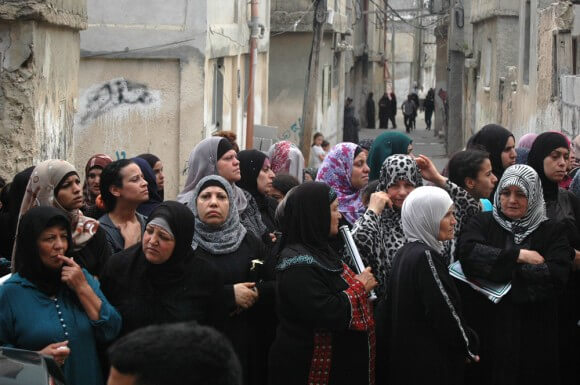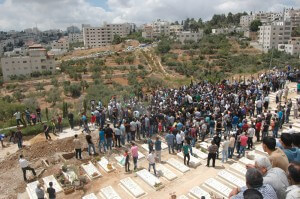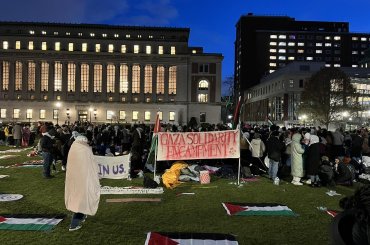

After months of unremitting tensions in the West Bank, another Palestinian youth was killed in a run of protests Friday near the settlement of Psagot outside of Ramallah. The funeral for Mohammed al-Qadary, 19, was held Saturday following noon prayers. Afterword mourners scrambled up a hillside cut with terraces for yet another round of clashes at the site where the teen was shot in the chest hours earlier.
Al-Aqsa Martyrs’ Brigades, the armed-wing of Fatah, wore balaclavas and fatigues and brandished semi-automatic weapons. One of the gunmen was dressed in a locally popular style of a navy snowsuit. They then fired a staggered salute.
“The last appearance for them [al-Aqsa Martyr’s Brigades], before this time was when some people were released from jail two months ago,” said Rajai Mahadira, 20, a friend and classmate of al-Qadary. “He lived in al-Amaari and everyone knows everyone. We are like a big family,” he continued.
Behind the gunmen, al-Amaari’s central mosque was plastered with martyrs’ posters, remembrances of those from the community who died by Israeli fire. Yet al-Qadary is the first from the refugee camp to be killed by the Israeli army since the Second Intifada.
By 11a.m. over a thousand had poured into the streets of al-Qadary’s home town, al-Amaari refugee camp, which is walking distance from downtown Ramallah. Scores of teens sported “We are with Gaza” tees, like the one that al-Qadary wore at the time of his death. They packed the slender sidewalks and narrow streets, a hallmark of refugee camp architecture; the disjointed intersections act as a crude reminder its residents’ displacement.
Mahadira positioned himself on the back of a rusty flatbed truck, so as to gain a height advantage to watch his schoolmate being carried for kilometers on the shoulders of men from his house to the burial ground near the settlement. Below him other teens passed out al-Qadary’s martyr poster, “There are a lot of martyrs in Gaza,” he said overlooking the image of the deceased wearing a tee-shirt in support of Gaza on the placard, “we are one people from one country,” he continued.

As Saturday was hailed as an international “Day of Range” with protests planned across the West Bank and Jerusalem in support of Gaza, al-Qadary’s mourners rallied near the settlement where he was killed. Demonstrating at Psagot is an escalation of sorts. Typically, calls for action focus on Qalandia checkpoint, the main valve in and out of the West Bank, or Ofer prison, the location of Israel’s military court where all detained Palestinians are sent for their trials. These are accessible sites of Israeli military infrastructure.
Indeed, until recently, protests have not taken place outside Psagot for years. Ordinarily the Palestinian Authority (PA) Preventative Security forces block the paths of demonstrators before they can get close enough to catch sight of Israeli localities. While the PA has been lauded over the years for keeping calm in the West Bank, what that means is that the officers beat back dissidents, even spray them with tear gas or shoot live fire. Protesters have sparred with the PA, throwing Molotov cocktails and rocks at them.
But one month ago the PA suddenly stepped back, leaving Palestinians free to mount actions against settlers and army infrastructure. The dissidents were met directly by the Israeli army, which injured 11 with live-fire. The following evening Fatah, the ruling political party in the PA, leafleted Ramallah calling for a united uprising against Israel.
The shift in the PA’s tactics and discourse came just as the conflict in Gaza erupted and on the heels of Israel’s Operation Brother’s Keeper, the largest military incursion in the West Bank in a decade. The Israeli’s stated mission was to find the captors of three teens who were kidnapped while hitchhiking in a settlement near Bethlehem on June 12th. Yet the operation included a show of force inside every West Bank major city and the arrest more than 500 Palestinians in just one month.
During that operation in early morning hours Israeli army jeeps paraded through Palestinian urban centers. In Ramallah that parade came to a head when Israeli and Palestinian forces shot at demonstrators in consort with live-fire, the PA unleashing a barrage of fire for 15 minutes that exceeded that of the Israeli army. People in Ramallah viewed the joint military effort as a betrayal by their government. And although the PA has never publicly addressed that momentary alignment with Israeli forces against their own population, they seemingly reevaluated their process of engagement with protesters.
Meanwhile Hamas is gaining traction in both the West Bank and Gaza. The PA has decidedly taken a hands-off approach on the ground, permitting Palestinians in the West Bank to hold pro-Hamas rallies– something that hasn’t happened since the 2006 government split with Fatah dominating the West Bank and Hamas Gaza.
Over the weekend in Cairo where talks were underway to negotiate a ceasefire between Israel and Hamas, the PA has proved indispensable to Israel and the U.S. because those countries do not negotiate directly with Hamas. The PA has taken on a central role in mediating Hamas’s conditions for a ceasefire– namely lifting the eight-year blockade of Gaza that has de-industrialized the coastal strip and sunk it into economic collapse.
Although led by Fatah, the P.A. has built the Palestinian coalition negotiating team to include an equal number of representatives from Fatah and Hamas, as well as seats for smaller parties. So the PA has quietly instituted the unity government that was announced last spring.
Israel did not want to see Palestinians from the West Bank and Gaza working together and took an iron-fist approach. Immediately it broke off the peace negotiations that were being led by John Kerry and cited Hamas as a terror group and blocked the transfer of PA aid funds to Gaza. By the time Israel’s Operation Protective Edge began one month ago, the collapse of the unity government had already caused every hospital in Gaza to announce a state of emergency. Al-Shifa, the main hospital in Gaza City, didn’t even have sutures when the Israeli air strikes started.
And so the PA is conducting a balancing act. It is allowing protests against Israel in the West Bank, which saves them from criticism over their controversial security coordination with Israel, while at the same time playing their trump card with Israel, which is that they are not Hamas. Fatah and the West Bank’s civil administration have finally garnered international recognition as a so-called moderate Palestinian faction. There are even drummings from Israel that describe Fatah as the legitimate government of Gaza too.
“Gaza belongs to Mahmoud Abbas, he is the only one with legitimate authority,” said President Shimon Peres in late July. “Gaza was stolen from him. The best thing to do is return it to him. He has proven that he knows how to lead, and he can save Gaza, with the help of Egypt and the Arab world,” he continued.
Peres’s remarks indicate that the former Israeli leader understands regional dynamics have changed in Fatah’s favor. No longer will Egypt turn a blind eye to Hamas, as any credence given to them is taken as a soft approach to the Muslim Brotherhood, which General Abdel Fattah el-Sisi has made a commitment to crush.
And yet the past month of fighting has raised the question, does Hamas need Egypt? Hamas is holding its own against Israel. Its stockpile of weapons exceeded IDF expectations, well as its stamina in the battlefield, which recalls the stalwart guerrilla fighters from Hezbollah in Lebanon in 2006.

One of the ironies that Gaza has brought to the surface is that while inside Gaza the resistance against Israel is popularly backed, Hamas as a government is not. The opposite is true in the West Bank, where Hamas the political party has gained traction. Their music blares from car radios across Ramallah, and it’s not uncommon to hear Christian or secular Palestinians speak favorably of a possible future Hamas-run government.
Fatah by comparison is still viewed overwhelmingly with indifference or contempt. As a truck driver from Ramallah noted when he made a U-turn to veer away from the clashes following al-Qadary’s funeral, “They do nothing. They don’t protect us.”
As he spoke a Red Crescent ambulance sped past him toward Ramallah’s public hospital carting away the first injury from Israeli fire.


Peres understands what most Palestinians understand, that is Abbas government has been footed into the occupation authority and they want to give them Gaza to pacify for Israel. That’s won’t work anymore. Israel prefers for a strong Hamas so that they can continue to say to the world how can we turn anything over to Hamas? They are deliberately with the ignorant help of America conflating Hamas with ISIS. Be careful what you wish for
On the first pic. Looks like a uniform to me. I would be hard pressed to take him for a civilian. I guess a 8 month old baby looks like that to an Israeli.
Many talking heads on US mainstream tv news/infotainment are conflating Hamas with ISIS, e.g., Dershie. Al Jazeera America just announced moments ago there’s been a truce agreement reached. Yesterday it was reported by The Forward that the Palestinian negotiators had softened their demands, and Livi announced her own–plan, which angers Likud’s hard line stance–see her plan here: http://blogs.forward.com/jj-goldberg/203830/palestinians-ease-truce-terms-as-livni-airs-new-pe/?
PA police is now showing some kindness to West Bankers after it has helped Israel round up all the who’s who of Hamas on the WB. When they’ll start turning their weapons on the Israeli forces to protect Palestinians, you can start believing in the change you are seeing. From where I’m standing, this is just a whitewashing PR gimmick.
the 47th street insurrection, bringing light unto the world.
Spontaneous Pro-Israel Rally Erupts in Response to Protestors
Amidst the raucous shouts of “Free, free Palestine!” a different call emerged. A pro-Israel crowd appeared, clapping and chanting “Is-ra-el, Is-ra-el!” Some business owners closed their stores to join, supporters flooded the sidewalk, and the street filled with chants celebrating Israel. The “Free Palestine” zealots looked dazed and confused, their voices out of unison, a couple of stray “Allahu Akbars” honked out as a last resort.
https://www.youtube.com/watch?v=NkZdVeb9iSY
a disturbing question of universalism , present , or historical, under an ethno religious supremacist body politic , that is where ethnicity and sect substantially overlap, eg shia persia, puritan new england, the sunni gulf, Hindu India and ‘Is Ra El” in New York or Palestine?